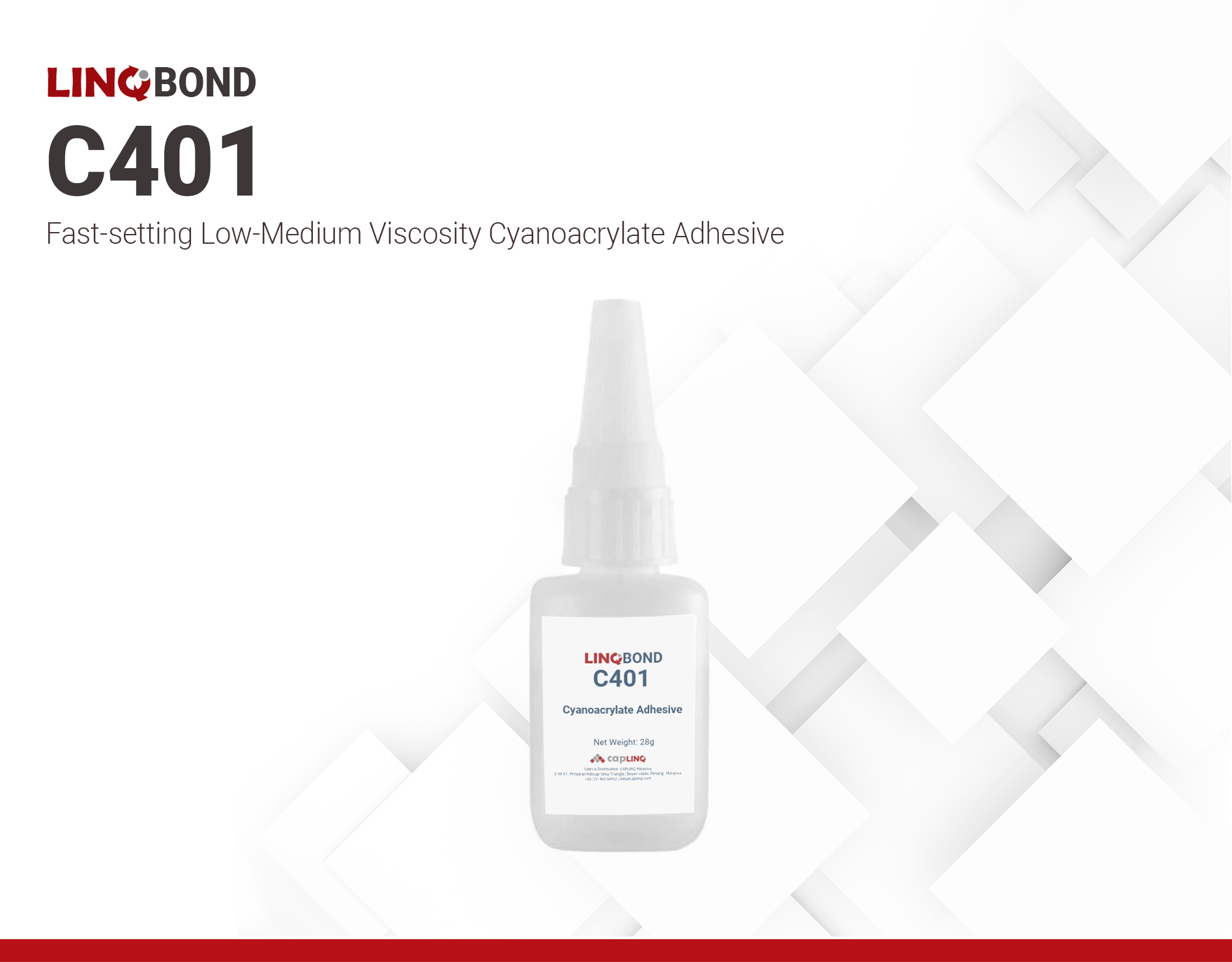C401 | Low-Medium Viscosity Cyanoacrylate Adhesive
Harmonization Code : 3506.91.90.99 | Prepared glues and other prepared adhesives, not elsewhere specified or included; products suitable for use as glues or adhesives, put up for retail sale as glues or adhesives, not exceeding a net weight of 1 kg ; Adhesives based on polymers of headings 3901 to 3913 or on rubber; Other ; Other
Main features
- Low to medium viscosity
- Rapid cure
- Biocompatible
Product Description
LINQBOND C401 is a single-component, low to medium viscosity ethyl cyanoacrylate adhesive formulated for rapid polymerization and high-strength bonding across different substrates, including fiberglass, wood, and leather. C401'S optimized rheological properties make it excellent for wicking and gap-filling applications for clearances up to 0.15 mm. LINQBOND C401 is ISO 10993-5 certified for biocompatibility.
Product Key Features
- Fast-curing — achieves fixture strength within seconds, minimizing clamping time and accelerating assembly processes.
- Low to medium viscosity — ideal for filling small gaps.
- Ambient temperature curing — does not require external heat source or curing equipment.
Applications
- Bonding of various components requiring biocompatible adhesive solutions.
- General industrial assembly
- Bonding of composite materials
Technical Specifications
| General Properties | |
| Appearance Appearance Appearance at room temperature. | Clear |
| Chemistry Type | Ethyl cyanoacrylate |
| Specific Gravity Specific Gravity Specific gravity (SG) is the ratio of the density of a substance to the density of a reference substance; equivalently, it is the ratio of the mass of a substance to the mass of a reference substance for the same given volume. For liquids, the reference substance is almost always water (1), while for gases, it is air (1.18) at room temperature. Specific gravity is unitless. | 1.06 |
| Physical Properties | |
| Viscosity Viscosity Viscosity is a measurement of a fluid’s resistance to flow. Viscosity is commonly measured in centiPoise (cP). One cP is defined as the viscosity of water and all other viscosities are derived from this base. MPa is another common unit with a 1:1 conversion to cP. A product like honey would have a much higher viscosity -around 10,000 cPs- compared to water. As a result, honey would flow much slower out of a tipped glass than water would. The viscosity of a material can be decreased with an increase in temperature in order to better suit an application | 105 mPa.s |
| Thermal Properties | |
| Flash Point Flash Point The flashpoint of a solvent is the lowest possible temperature at which it can vaporize to form an ignitable vapor. Flashpoint is often confused with “autoignition temperature”, which is the temperature at which a solvent ignites without an ignition source. | 85 °C |
| Operating Temperature | -55 - 95 °C |
| Other Properties | |
| RoHS Compliant RoHS Compliant RoHS is a product level compliance based on a European Union Directive which restricts the Use of certain Hazardous Substances in Electrical and Electronic Equipment (RoHS). Products compliant with this directive do not exceed the allowable amounts of the following restricted materials: lead, mercury, cadmium, hexavalent chromium, polybrominated biphenyls (PBB) and polybrominated diphenyl ethers (PBDE), with some limited exemptions | Yes |
Additional Information
LINQBOND C401 Additional Technical Specification
Table: LINQBOND C401 Solvent Resistance
| Solvent | Includes | Resistance |
| Alcohol | Ethanol, Methanol | ⁕⁕⁕ |
| Esters (aromatic) | Ethyl acetate | ººº |
| Ketones (aromatic) | Acetone, benzophenone | ººº |
| Aliphatic Hydrocarbon (alkanes) | Petrol, hexane, heptane | ⁕⁕ |
| Aromatic Hydrocarbon | Benzyl, xylol, toluol | ⁕⁕ |
| Halogenated Hydrocarbon | Chlorobenzol, chloroform, methylenchloride | ººº |
| Weak aqueous acid1 | Weak aqueous solutions of hydrochloric acid, sulfuric acid, nitrous acid, and phosphoric acid | ⁕⁕⁕ |
| Weak aqueous base1 | Weak aqueous solutions of sodium hydroxide and potassium hydroxide | ⁕⁕⁕ |
1 C401 is not resistant to high concentrations of acids and bases.
Table: LINQBOND C401 Bond Strength on Substrates
| Substrate | Strength (N/mm2) |
| Steel | 13.8 - 17.0 |
| Rubber | 4.8 - 15.2 |
| Aluminum | 14.3 - 16.1 |
| Polycarbonates | 23.3 - 27.8 |
| Acrylonitrile Butadiene Styrene | 14.5 - 17.5 |
| Polyvinyl Chloride | 17.7 - 24.4 |
Table: LINQBOND C401 Cure Time on Substrates
| Substrate | Time (seconds) |
| Steel | 7 |
| Acrylonitrile Butadiene Styrene | 10 |
| EPDM Rubber | 2 |
Instructions for Use
- Ensure parts are clean, dry and free from contaminants such as oil and grease.
- Apply product to one side and hold parts until handling strength is achieved. Ensure there is adequate, even pressure between parts. A sufficient bond is formed in less than a minute and maximum strength is attained in 24 hours.
- Wipe off excess adhesive from the top of the container and recap. Avoid exposure to air as moisture may degrade the adhesive.



